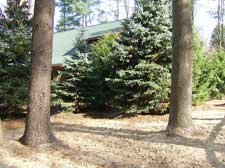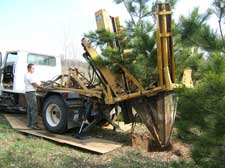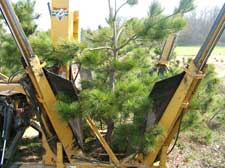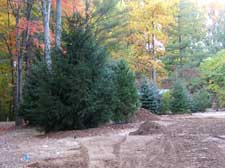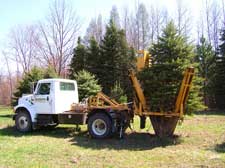Tree Spading
Benefits of Trees
Social Benefits:
Beauty
Shade
Creates a feeling of serenity, peacefulness, restfulness and tranquility
Represents stature, strength and endurance
frequently planted as living memorials
Communal Benefits:
Provide privacy (visual and audio)
Emphasize views
Screen out objectionable views
Reduce glare and reflection
Direct pedestrian traffic
Provide background, soften, complement or enhance architecture
Environmental Benefits:
Provide habitat for wildlife
Provide Climate control
Improves air quality
Moderates the effects of sun, wind and rain
Economic Benefits:
Air conditioning costs are lower in a tree shaded home
Heating costs are reduced when a home has a wind break
Trees increase in value from the time they are planted until they mature
Landscaped homes are more valuable than non-landscaped homes
Needs and Considerations
The Need to Transplant a Tree:
The tree has overgrown its original location
To accommodate new structures/additions
To move a tree from one site to another
To save a tree from construction
To move a tree to a location better suited to its needs
To change the aesthetic appearance of a landscape
To plant a new tree that is too large to be handled as "balled and burlaped"
Considerations for a 50" Tree Spade:
This machine is capable of moving a tree up to 5 inches in diameter (take measurement on the trunk of the tree, 12 inches up off the ground) This machine needs at least 8 feet around the tree with no obstructions (deck, buildings, other trees, etc. )The tree spade truck is a very large vehicle. It is possible that the truck could leave depressions in your lawn, especially if you have an irrigated yard or it has recently rained. For an additional charge plywood can be laid down to help protect the lawn from damage.
Planting Process
New Tree Planting:
Think of the tree you will purchase as a lifetime investment. How well your tree and investment
grows depends on the type of tree and location you select for planting and the care you provide
before, during and after planting the tree.
The ideal time to plant trees is during the dormant season (September-April). However some evergreen trees that are properly cared for in the nursery, during transport and
especially after planting can be transplanted during the growing season (after new growth has hardened off, ~July 1st).
Before you begin the planting process, be sure you have had ALL underground utilities located
prior to digging!
It is important to understand that during the transplanting process, a spaded trees root system will be reduced by up to 70%
(depending on the size of the tree) of its original size. As a result of the
digging process, trees will commonly exhibit what is known as transplant shock. Proper site
preparation before and during planting along with good follow up care will reduce the amount of
time the tree experiences transplant shock and will allow the tree to quickly establish in its new
location.
Pre Planting:
If your soil conditions are different from the trees original location or are just plain unsuitable, soil amendment may be required. On most planting sites in new developments there is little to no quality top soil, the existing soils have been compacted and are unsuitable for healthy root growth. If these conditions exist, digging a hole as much as three times the diameter of the root ball may be required for container or bailed and burlaped trees. For spaded trees, a berm may need to be created. High quality soil (contains organic matter, allows for aeration and proper drainage) will allow the newly emerging roots room to expand into the new soil which will enhance vigor and vitality in the tree.
Post Planting:
Staking the Tree
Protective staking may be required on sites where lawn mower damage, vandalism, or windy conditions are concerns. Remove support staking and ties after the first year of growth.
Mulching the Base of the Tree
Mulch acts as a blanket to hold moisture, moderate soil temperature extremes (both hot and cold) and reduces competition from grass and weeds. A three-to four inch layer of mulch is ideal: more than four inches may cause problems with oxygen and moisture levels. When placing mulch be sure not to cover the actual trunk of the tree. This may cause decay of the living bark at the base of the tree. A mulch-free area of three inches wide at the base of the tree is sufficient.
Watering the Tree
Keep the soil moist but not soaked (over-watering can be as damaging as under-watering). Remember, clay based soils hold water longer while sand based soils drain water faster. A watering basin may need to be created using topsoil. This will help keep the water over the rootball, where it is needed. Water the tree once a week and more frequently (2-3 times per week) during hot, dry weather. When the soil is dry below the surface of the mulch it is time to water. During the year water the tree from ~March thru October. Remember, evergreen trees keep their needles all year, so they need water all year. Give evergreen trees some water right up until the ground freezes.
Fertilizing the Tree
Allow the tree to remain in its new site for a year before fertilizing. Fertilizer can actually cause production of more top growth than the root system is capable of supporting. The goal during the 1 year is re-establishment of the root system and not promotion of growth to the plants above ground structure. To help promote new root growth a root stimulator and Mycorrhizal fungi application is recommended at the time of planting and throughout the first growing season.
Scheduling and Installation
Scheduling:
We can first have a consultation to view the property and discuss the processes involved. Before any digging is started, MISS DIG ( 1-800-482-7171 ) must be called. This is a free utility location service. They need to be called three business days prior to your scheduled dig. After we have confirmed there are NO buried utilities where you would like your tree, we will schedule a time frame of when your tree will be installed. Please remember, that if it rains in between the time that we notify you and the time the installation is scheduled that it may delay your installation, but we will let you know.
Installation:
The spade truck will come and dig a hole where your new tree is to be planted. We will then go to a nursery, to pick up (dig) your tree, and return to your property and plant your new tree. If the tree you wish to move is already on your property it will be the same process. First dig the hole then dig the tree and place it in its new site. The plug of soil that is dug from the area where your new tree will now be, is used to fill the hole from where your tree came from. After planting with the tree spade, staking and mulching as well as root stimulating is recommended.








